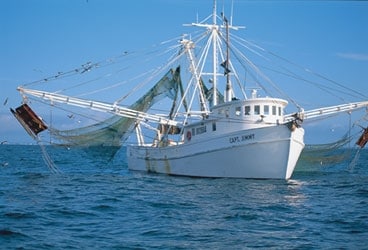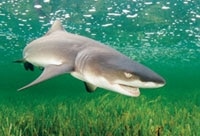
Shark 200
[Be sure to click through all the images in the gallery above.]
You can plan fishing trips with the greatest care and down to the smallest detail, selecting the right location, right tides, right winds, right time of year, right flies and, of course, the right tackle. You think, This has to work. We’ve been planning this thing for over six weeks. But there’s a saying about the best-laid plans going astray, and nowhere is that more applicable than in fishing.
An open mind is one of the most import components of a well-thought-out strategy. When conditions aren’t lining up just right for the trip you wanted, you need to have a plan B. For some people, this might mean picking up a spinning rod and a piece of bait, but another way to make a productive day out of one that isn’t going as expected is to look for nontraditional species to cast a fly to.
“Sharks?” you say? Yeah, that’s right – they pull hard, jump, will eat a fly (with a little coaxing), can be plentiful and love to visit a chum bag. Fly-anglers have fished for sharks on the flats of the Florida Keys, along the east coast of Florida, off New York and California, and in the Gulf of Mexico for years. And now fly-rodders in the mid-Atlantic are starting to get on board with the trend as recreational and commercial limits and management plans are bolstering coastal shark populations.
I live in the Outer Banks of North Carolina, and during summer months fly-fishermen usually look for cruising cobia and jack crevalle on the ocean’s surface or amberjack around the reefs and wrecks. But on some days the conditions just aren’t right or the guests of honor don’t show. Luckily you have a couple of options: One, you can continue to grind it out, or, two, you can look for other opportunities until conditions improve. Not every situation lends itself to plan B’s or even C’s, but anglers in most places will find that they have an array of fly-eating toothy fish that can turn a seemingly off day into an off-the-charts experience.
On many days, cloudy skies and choppy seas out of Oregon Inlet frustrate summertime cobia fishermen. When conditions make it difficult to find them, it’s time to switch gears. The same areas you find cobia – along the beaches from just behind the surf zone to 70 feet of water or deeper and along tide lines and temperature changes – are good places to drop a chum bag and see who comes to visit. In my area the two most common shark species we encounter are the Atlantic sharp-nose and the blacktip. But the same tactics work in other places such as the Gulf of Mexico, where anglers frequent offshore oil rigs in search of tuna, kingfish, jacks and more. Where you fish will dictate what kind of sharks you encounter, but for the most part inshore sharks behave the same. Around Montauk, New York, the waters hold blue sharks and makos. The southeast Florida coast means spinner sharks and blacktips, and from its Panhandle all the way to Louisiana in the Gulf, lemon, bull, blacktip, dusky and sandbar sharks can show up behind shrimp boats or be chummed up near the rigs. But no matter what species appears boat-side, similar tackle and techniques apply. So once you know the basics of shark fishing, you’ll be able to target them in different areas.
Preying on Predators
The first step is to lure sharks in with an effective chumming method. This can be as simple as dropping a chum bag over the side of the boat with several blocks of ground menhaden (bunker). You can also supercharge the chum with oil from fresh-cut menhaden or any old fish carcass. Most times chum blocks are all you’ll need. Chumming while drifting can be a productive way to locate sharks, and when they arrive you can anchor or continue to drift. As I said before, most anglers in my neck of the woods chum for sharks because the wind is up and the seas are choppy. Drifting makes these conditions more tolerable, but if you’re moving faster than 1.5 knots, you might consider dropping a sea anchor over the side to slow your pace.
While the slick feeds out from the boat and you wait for the guests of honor, it’s a good time to rig up. You’ll need wire shock tippets to deal with the teeth, and tieable versions like Tyger and Boa make adding these very easy. Most of these materials can be attached with double surgeon’s knots. Lefty’s Deceivers are effective fly patterns, especially all white; red and orange; red, orange and yellow; and olive and white. It’s a good idea to have some with more flash than others. For rods, 9- to 11-weights rigged with intermediate fly lines are perfect for sharking, but you might also want to keep one rigged with 20-pound tippet, 30-pound mono shock and your favorite fly in case other species like cobia or jacks show up in the slick.
As you’re rigging and once you’re ready to go, keep looking down the chum slick for sharks. That’s the advantage of this method – you know where they’ll come from. In the Outer Banks, most Atlantic sharp-nose and blacktip sharks will be small – 36 to 50 inches long – but I have seen bigger ones. Like many other kinds of sharks, both of these species can be very timid at times, but they will chase and eat flies. Other regular visitors to my local chum slick are hammerheads and the occasional sandbar shark. In different areas you’ll be looking for different species.
The more sharks that appear in the chum slick the better – overall they are shy, but they become more aggressive with competition. When they start to gather in the chum slick, the most effective way to target them is to sight-cast to them. Try to keep the fly in front of the shark and strip it slowly. You have to watch closely; sharks will rub the sides of their heads on the fly to try to get a “feel” of a potential meal. If the fly disappears, set the hook immediately. Another good tactic is to make longs casts toward the end of the chum slick and retrieve the fly slowly. This blind-casting will often bring strikes from sharks hanging in the back of the slick.
Even with the right chum techniques, sharks sometimes need a little encouragement. A live teaser will certainly fire things up, and it works great for bait-and-switch. Live eels are easy to get in most areas and easy to use. Just take a spinning rod with a mono leader and use either a small hook or a snap swivel to attach the eel through the mouth. If eels aren’t available, squid strips work very well, too. You can also cut up the squid and pitch a few pieces into the water, then cast an all-white Deceiver. Either way, hold your teaser close to the boat, and, when a shark tries to take it, pull it away but not too far. Have the angler cast a fly near the bait, or lead the shark to the fly with the bait.
Sealing the Deal
All species of sharks have two or more rows of teeth enclosed in one of the toughest mouths a fish can have. To get a good hook-set, you have to use a quick series of firm strip strikes. Usually sharks get hooked in the lip, which is quite strong. So if you get a good set, the shark will probably stay on unless the line or leader rubs excessively against its rough skin or another shark cruising nearby grazes it.
Most of the sharks fly-fishermen target are plenty sporty on a 9-weight and will jump and pull pretty hard. But if you’re going after big sharks, you should bring bigger guns with strong backbones and fighting butts. Spinner sharks off the coast of Florida range from 50 to 100 pounds, while hammerheads in the Keys can go hundreds of pounds. (See “Shark Fishing, Southern Style” on page 53.) When you’re fighting any kind of hard-pulling shark, you have to be on your best game to get them in fast, before you’re both too tired to recover. Keeping your rod low and off to the side in the Stu Apte “down-and-dirty” tradition of fighting big fish will maximize your efforts. While many species of sharks make blistering runs, some, like blue sharks, will try to go down in deeper water. In this situation, you have to “short-stroke” them, or lift the rod only slightly and try to get one crank at a time on the reel. Captains typically don’t like to use the boat too much because you could trash your chum slick or wind up much farther away from it than you’d like.
You’ve done everything right – the fishing gods have kept those other hungry sharks far from your fly line, and your 50-pounder is just inches from the boat.
Now you are ready to snap a few pictures, give your fish a kiss and send it on its way. When it gets alongside the boat, use caution. No matter how small a shark is, they are all very limber and can easily bend around and bite you. Even the smallest of teeth are razor-sharp and can do some serious damage. The best idea is to use some type of dehooker to remove the fly while the shark is still in the water next to the boat. You can also use bronze hooks and release your catch with a little lip jewelry – it will rust loose very quickly in salt water. Either option is better than playing tag with a toothy, pissed-off predator thrashing around the inside of your boat.
Getting Shrimpy with It
Near what’s called the “Crystal Coast” off Morehead City, North Carolina, fly-anglers are discovering great shark action, and they’re not limited to one area or one species. The more they fish here and the Cape Lookout area, the more fly-hungry sharks they find. Part of their success is knowing where to look, and part is employing a tactic Gulf Coast anglers have been using regularly for years – fishing behind shrimp boats.
The first place to look for a shark attack here is Beaufort Inlet. Drop a chum bag along the buoy chain heading out to the Sea Buoy. If you don’t get any results, try farther out the chain. It’s good to have some live or fresh menhaden for extra spice in the slick, as well as a couple of rods – one with an intermediate line and the other with a sinker. Many anglers prefer integrated heads, like Scientific Anglers’ Streamer Express or Rio’s Density Compensated Lines. Both of these have a 25- to 30-foot sinking or intermediate tip with an intermediate running line. Keep an eye out for the occasional king mackerel as you watch the slick for sharp-nose, blacktips and possibly sandbar and hammerhead sharks.
Late in summer a real shark bonanza takes place around Beaufort Inlet when shrimp boats start fishing the ocean at night and culling their catch in the mornings.
The cull consists of small croakers, spots, pinfish and other bottom dwellers. This stream of fish drifting back in the current attracts quite the crowd. Last August, Capt. Joe Shute and I fished over some wrecks and live bottom out of Beaufort Inlet and were totally shut out. He mentioned the shrimpers, so the next morning we followed our backup plan and found that it wasn’t just good, it was off the charts! We pulled up to the first shrimp boat, and I cast at the back of it, just missing a nice jack crevalle. The cull was drifting toward the bow of the boat, so we motored around and found a long chum line with literally a hundred sharks of all sizes happily feeding. They were eating little croakers off the surface and just under it – they were everywhere! There were just too many targets! This carnage turned two seasoned anglers into little kids squealing with excitement as if they were on their first fishing trip.
This kind of fishing is nothing new in the Gulf where anglers routinely trail commercial vessels to target the variety of species noshing on the boat’s wash and bycatch. Prepared fly-fishermen also know that a couple of six-packs negotiated with a thirsty crew can translate into more chum than you know what to do with.
In these situations, you will find some bruisers in the mix, so 9- to 12-weight rods are the ticket. We tried all the standard-color shark flies, but red/orange/yellow Deceivers with gold flash drew the most interest. Sometimes slow strips that kept the fly in front of the shark worked best, while other fish preferred the dead drift-back with the cull. You can also get their attention by slowly twitching poppers or other surface flies.
Another sharky mid-Atlantic place is Cape Point. The day Shute and I scouted the area, the water was gin-clear with lots of current running out to the tip of the shoals. We saw the dark shapes from 200 feet off the beach to within 3 feet of the shore. At one time we counted 30 fish milling about, and some of these sharks were big “Moes” that would have required 12-weights and up. If we’d had time and chum, it would have been a lot of fun to let these big fish work us over. The most important thing was that we knew where to look and how to spot them.
So in the future, don’t paint yourself into a corner when planning fishing trips. While there’s always a first species of choice, you should never hit the water without a plan B – or even plans C to Z in your back pocket. Who knows, one of the backups may turn out to be so much fun that it moves to the top of your A-list.
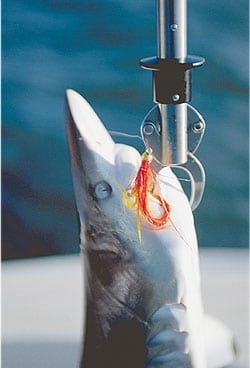
Shark Attack!
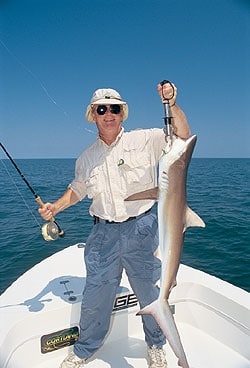
Shark Attack!
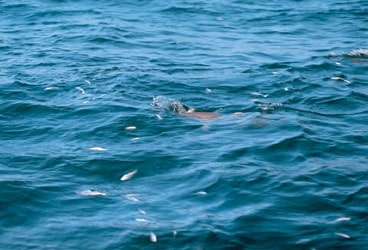
Shark Attack!
